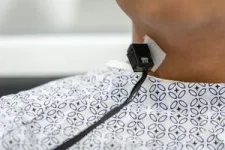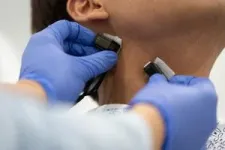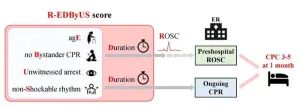(Press-News.org) A research team led by UC San Diego has, for the first time, shown that a wearable, non-invasive device can measure activity in human cervical nerves in clinical settings.
The device records what the team calls Autonomic Neurography (ANG), neural activity from the human vagus and carotid sinus nerves as well as other autonomic nerves found in the skin and muscle of the neck. The vagus nerve is a “superhighway” of the involuntary nervous system, with tendrils extending from the base of the skull through the torso and abdomen to influence digestion, heart rate and the immune system. The vagus nerve plays a pivotal role in the body’s inflammatory response to injury or infection, and has been a focus for research into deadly conditions like sepsis, a leading cause of emergency room deaths affecting at least 1.7 million adults in the U.S. each year according to the National Institute of General Medical Sciences, and post-traumatic stress disorder, which affects about 3.5% of the population according to the National Institute of Mental Health.
To offer medical professionals a real-time, clinically proven tool for detecting levels of activity in the involuntary nervous system, an early warning sign of a body under stress, the researchers designed a flexible, adhesive-integrated electrode array (as reported in a 2022 Scientific Reports paper). The current study, published July 29, 2024 in Nature Communications Biology, used this approach with the aim of detecting deep neural activity in a simulated clinical hyperinflammatory model.
“We are encouraged by our results. The device is poised to provide an early diagnostic marker of pathogen infection, or inflammation from a pathological process,” said the study’s senior author Imanuel Lerman, head of the Lerman Lab of UC San Diego’s Qualcomm Institute, School of Medicine, and Jacobs School of Engineering, as well as the VA Center of Excellence for Stress and Mental Health. Lerman is the founder of InflammaSense Inc., the company that licenses the device’s technology. “Based on the study results, we are now deploying the device at the intensive care units of the Jacobs Medical Center at UC San Diego Health. The device will detect early involuntary neural signaling indicative of impending sepsis.”
Troy Bu, a Ph.D. candidate in the Jacobs School’s Department of Electrical and Computer Engineering, is the study’s first author.
Real-Time in the Emergency Room
To replace surgically implanted microelectrodes to monitor or activate the vagus nerve, the new device leverages a powerful technique called “magnetoneurography” to more accurately detect cervical nerve firing non-invasively in real-time. The device detects the magnetic fields arising from activity in the vagus and carotid sinus nerves, which “pulse” to warn the involuntary nervous system of a threat.
Researchers tested the device in nine adult human subjects. Patients had their blood drawn and their plasma tested for baseline levels of inflammation-triggering proteins called cytokines. Next, they were injected with bacteria-sourced toxins called lipopolysaccharides, inducing a temporary hyperinflammatory state in the body that mimicked the inflammation associated with a blood infection.
Inside a magnetically shielded room at the UC San Diego Qualcomm Institute Magnetoencephalography Center, researchers placed sensors from their device at points of the vagus nerve beneath the right ear and over the right carotid artery, where both the vagus nerve and carotid sinus nerve are found. The device monitored heart rate and the magnetic fields arising from nerve activity.
Within half an hour of the patients’ injection with lipopolysaccharides, the device detected changes in their nerve activity below the right ear. Researchers confirmed the rise in nerve activity and the release of inflammatory proteins through blood samples. They also recorded changes in heart rate throughout, as well as a noticeable link between nerve firing at both sites and changes in a particular inflammatory cytokine called tumor necrosis alpha, or TNF-α and the anti-inflammatory cytokine called IL-10.
TNF-α is a herald of sorts; patients with high levels are at a higher risk of entering septic shock, a deadly condition where the body’s inflammatory response overshoots the mark and causes devastating system-wide effects that can ultimately result in death.
Elevated levels of IL-10, on the other hand, can indicate patients at risk of immunoparalysis, a condition that occurs during sepsis when immune cells are unable to fight off either foreign or resident microbes, or resident viruses that can lead to uncontrolled infection and death.
“With sepsis, every minute counts and early treatments save lives,” said Bu. “Early sepsis detection is critical as, every hour sepsis is not treated, the likelihood of death increases by up to seven percent. Our technology can provide doctors with an early warning sign of hyperimmune or immunoparalysis response in sepsis. Doctors can then provide the correct treatment as quickly as possible.”
As in the 2022 study, researchers again found that patients separated into groups with distinct responses to the stress of the injection. Some patients showed higher peaks in the presence of inflammatory proteins and stronger side effects, while others’ peaks were lower.
With this technology, doctors may be able to identify subgroups of patients at higher risk of a hyperactive immune response and immunoparalysis, both of which contribute to sepsis-related complications and mortality. The device may also be used to determine whether treatments are reducing inflammation in the body, to better understand the nervous system and inflammation in people experiencing PTSD and other mental health conditions, and to tailor the dosage of therapies that target individual patients’ nervous systems.
This study was a collaboration between UC San Diego, Sandia National Laboratories, the University of Wisconsin-Madison, the VA Center for Stress and Mental Health, Quspin Laboratory, Stanford University and InflammaSense Inc.
Funding was provided by the Biomedical Advanced Research and Development Authority (BARDA) and the David and Janice Katz Neural Sensor Research Fund in Memory of Allen E. Wolf.
END
UC San Diego researchers use non-invasive technique to record involuntary nervous system
The technology could help shed light on the involuntary nervous system’s role in sepsis, PTSD and other inflammatory conditions
2024-07-29
ELSE PRESS RELEASES FROM THIS DATE:
Most US voters agree on basic human values – so is polarization exaggerated?
2024-07-29
The vast majority of American voters think alike on what they find important in life, but both Republicans and Democrats fail to recognise their shared views and values, according to new research from the Universities of Bath and Essex.
This finding is revealed today in the academic journal Social Psychological and Personality Science less than a month after the US Republican presidential nominee Donald Trump survived an assassination attempt when a gunman shot at him during a campaign rally.
“There’s a general perception ...
Optical fibers fit for the age of quantum computing
2024-07-29
A new generation of specialty optical fibres has been developed by physicists at the University of Bath in the UK to cope with the challenges of data transfer expected to arise in the future age of quantum computing.
Quantum technologies promise to provide unparalleled computational power, allowing us to solve complex logical problems, develop new medicines and provide unbreakable cryptographic techniques for secure communications. However, the cable networks used today to transmit information across the globe are likely to be sub-optimal for quantum communications, due to the solid cores of their optical fibres.
Unlike regular optical ...
Do non-statin cholesterol-lowering drugs affect liver cancer risk?
2024-07-29
Past studies have suggested that taking cholesterol-lowering statin drugs may lower individuals’ risk of developing liver cancer. In a new study of non-statin cholesterol-lowering medications, one type was linked to lower risks of liver cancer. The findings are published by Wiley online in CANCER, a peer-reviewed journal of the American Cancer Society.
Cholesterol absorption inhibitors, bile acid sequestrants, fibrates, niacin, and omega-3 fatty acids are types of non-statin cholesterol-lowering medications prescribed to manage cholesterol and lipid levels. The different classes ...
Every minute counts: rapid and accurate prediction model for cardiac arrest treatment
2024-07-29
When it comes to treating cardiac arrest, acting quickly can mean the difference between life and death.
Researchers from Osaka Metropolitan University have developed a new scoring model, using only prehospital resuscitation data, that accurately predicts neurological outcomes of patients with out-of-hospital cardiac arrest (OHCA). This model potentially allows healthcare providers to make quick and accurate decisions upon the patient’s arrival at the hospital, ultimately improving patient care and resource allocation.
Their findings were published in Resuscitation on May 31.
Cardiac arrest can lead to death within minutes. OHCA is not uncommon and often results ...
Hypertensive disorders of pregnancy increasing in Canada
2024-07-29
In Canada, rates of hypertensive disorders of pregnancy (HDP) have increased, but the good news is there has been a decline in some related health conditions, according to new research published in CMAJ (Canadian Medical Association Journal) https://www.cmaj.ca/lookup/doi/10.1503/cmaj.231547.
Hypertensive disorders of pregnancy include chronic hypertension (high blood pressure), gestational hypertension, and preeclampsia or eclampsia. These disorders affect 5%–10% of pregnancies worldwide, and cause more than 50 000 maternal deaths and 500 000 deaths in fetuses and infants ...
Is free genetic testing really free?
2024-07-29
Free genetic testing, offered partially or fully subsidized by industry, may have trade-offs, and health systems in Canada must carefully weigh potential clinical, ethical, and legal considerations to protect patient data, authors argue in a CMAJ (Canadian Medical Association Journal) commentary https://www.cmaj.ca/lookup/doi/10.1503/cmaj.231588.
“Near- and long-term expansion in no-cost testing and industry partnership in genetics, with patient data as the commodity, is likely,” writes Kirsten ...
Health: Short-term vegan diet associated with reductions in biological age estimates
2024-07-29
Eating a vegan diet for eight weeks is associated with reductions in biological age estimations based on levels of DNA methylation — a type of chemical modification of DNA (known as an epigenetic modification) that alters gene expression but not DNA itself. Previous research has reported that increased DNA methylation levels are associated with ageing. The findings, which are based on a small randomised controlled trial of 21 pairs of adult identical twins, are published in BMC Medicine.
Varun Dwaraka, Christopher ...
Evidence-based information combats misleading and false claims on the internet and social media about the anti-Mullerian hormone test
2024-07-29
Researchers in Australia have found that when women are given accurate information about a test that indicates the number of eggs in their ovaries, they have less interest in taking the test compared to women who viewed information available online.
The researchers initiated the study, which is published today (Monday) in Human Reproduction [1], one of the world’s leading reproductive medicine journals, because of the large amount of misleading and incorrect information promoted to women about the anti-Mullerian hormone (AMH) test on websites, including fertility clinic websites, and via social media.
AMH ...
Steel industry’s net zero drive could make lower-grade iron ore viable
2024-07-29
A decarbonised steel industry that includes carbon dioxide removal techniques in its net zero arsenal could use lower-grade iron ore, according to a new study.
Steel accounts for 5-8% of carbon dioxide emissions globally. Its total emissions have risen over the past decade, largely due to increased demand.
The International Energy Agency has stated that, without innovation, the scope to limit emissions is ‘limited’. Therefore, the commercialisation of new zero-emission production processes is critical.
Innovative ...
Plasma phosphorylated tau 217 and Aβ42/40 to predict early brain Aβ accumulation in people without cognitive impairment
2024-07-28
About The Study: The results of this cohort study suggest that combining plasma p-tau217 and Aβ42/40 levels could be useful for predicting development of Aβ pathology in people with early stages of subthreshold Aβ accumulation. These biomarkers might thus facilitate screening of participants for future primary prevention trials.
Corresponding Authors: To contact the corresponding authors, email Oskar Hansson, M.D, Ph.D. (Oskar.Hansson@med.lu.se) and Shorena Janelidze, Ph.D. (shorena.janelidze@med.lu.se).
To access the embargoed study: Visit our For The Media website at this link https://media.jamanetwork.com/
(doi:10.1001/jamaneurol.2024.2619)
Editor’s ...
LAST 30 PRESS RELEASES:
Space computing power networks: a new frontier for satellite technologies
Experiments advance potential of protein that makes hydrogen sulfide as a therapeutic target for Alzheimer’s disease
Examining private equity’s role in fertility care
Current Molecular Pharmacology achieves a landmark: real-time CiteScore advances to 7.2
Skeletal muscle epigenetic clocks developed using postmortem tissue from an Asian population
Estimating unemployment rates with social media data
Climate policies can backfire by eroding “green” values, study finds
Too much screen time too soon? A*STAR study links infant screen exposure to brain changes and teen anxiety
Global psychiatry mourns Professor Dan Stein, visionary who transformed mental health science across Africa and beyond
KIST develops eco-friendly palladium recovery technology to safeguard resource security
Statins significantly reduce mortality risk for adults with diabetes, regardless of cardiovascular risk
Brain immune cells may drive more damage in females than males with Alzheimer’s
Evidence-based recommendations empower clinicians to manage epilepsy in pregnancy
Fungus turns bark beetles’ defenses against them
There are new antivirals being tested for herpesviruses. Scientists now know how they work
CDI scientist, colleagues author review of global burden of fungus Candida auris
How does stroke influence speech comprehension?
B cells transiently unlock their plasticity, risking lymphoma development
Advanced AI dodel predicts spoken language outcomes in deaf children after cochlear implants
Multimodal imaging-based cerebral blood flow prediction model development in simulated microgravity
Accelerated streaming subgraph matching framework is faster, more robust, and scalable
Gestational diabetes rose every year in the US since 2016
OHSU researchers find breast cancer drug boosts leukemia treatment
Fear and medical misinformation regarding risk of progression or recurrence among patients with breast cancer
Glucagonlike peptide-1 receptor agonists and asthma risk in adolescents with obesity
Reviving dormant immunity: Millimeter waves reprogram the immunosuppressive microenvironment to potentiate immunotherapy without obvious side effects
Safety decision-making for autonomous vehicles integrating passenger physiological states by fNIRS
Fires could emit more air pollution than previously estimated
A new way to map how cells choose their fate
Numbers in our sights affect how we perceive space
[Press-News.org] UC San Diego researchers use non-invasive technique to record involuntary nervous systemThe technology could help shed light on the involuntary nervous system’s role in sepsis, PTSD and other inflammatory conditions






